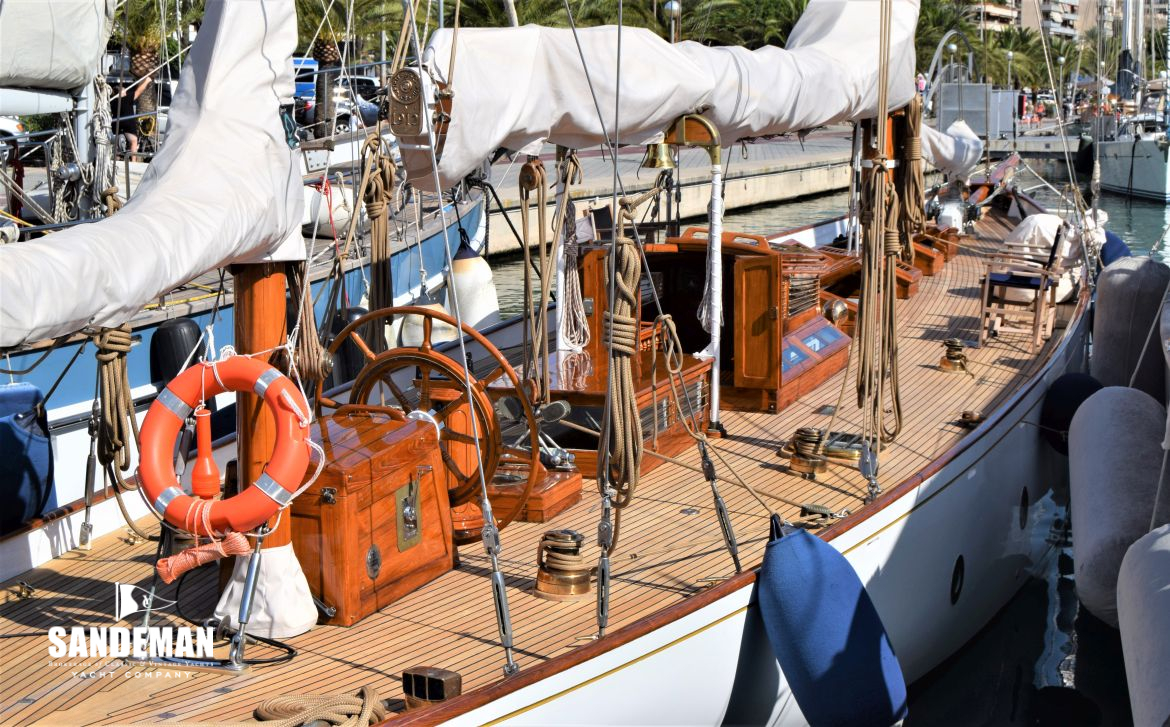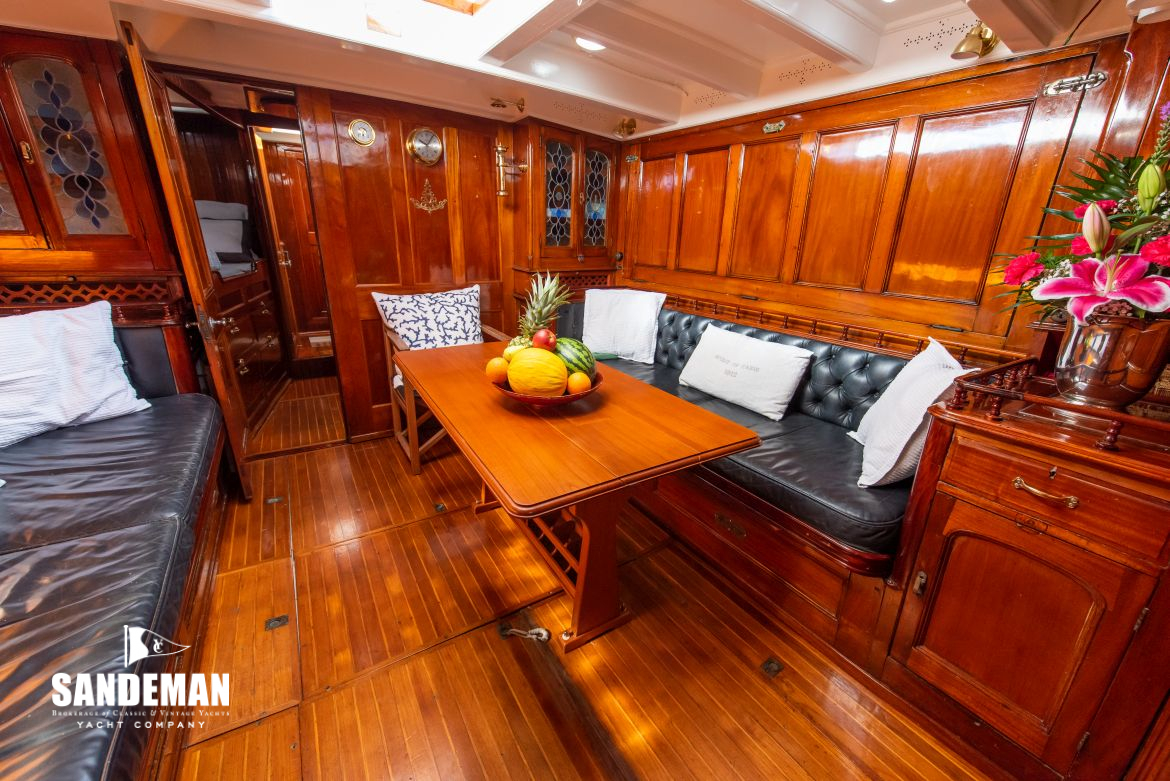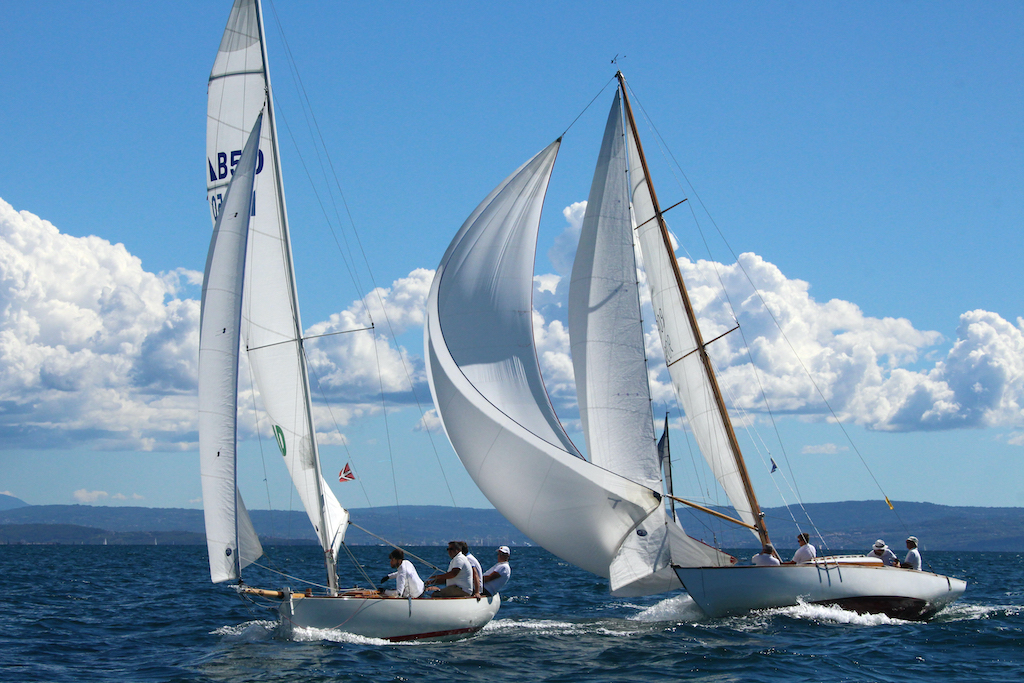






Cariba may be said to have been born with a silver spoon in her mouth, having had the good fortune to be built – to Lloyd’s then top wood yacht classification, 18A1 – by one of the finest English yards of the Victorian and Edwardian period, J.G. Fay & Co., of Northam, Southampton – now better known as “Shamrock Quay”. Landing on the cabin sole from her elegant, turned companionway stair is like alighting from a time machine. The quality of her mahogany panelled accommodation would be well-nigh impossible to replicate now without a mighty guilty conscience – or access to a barn-find of old growth lumber.
She was commissioned by 47-year-old London lawyer and Vice-Commodore of the Royal Corinthian Yacht Club, Allan E. Messer, of Old Jewry Chamber and Belgravia – a time-served yachtsman in smaller boats together with his more famous brother, the architect Arthur Albert Messer, who worked in both the UK and New York and Texas in the USA. In later life, through the 1920s and 30s Allan E. Messer would become part and then sole owner of the Fife 19-Metre MARIQUITA; her last owner as a yacht until her epic 1990s rescue and 2000s restoration.
As designed and built – as CARIB – she was a gaff-rigged yawl, the only motive power being her suit of Ratsey & Lapthorn sails. She still sails today under Ratsey & Lapthorn cloth, but with the auxiliary benefit of a 291 hp Yanmar “iron mainsail”.
After the First World War she moved to Denmark and became – as CARIBA – mothership to serial racing yacht (and Copenhagen department store Magasin du Nord – “the Harrods of Scandinavia”) – owner William Vett’s ever changing collection of International 6-Metres. Vett won the first of his two 6mR Class Olympic Silver Medals at Le Havre in 1924. It is nice to speculate that CARIBA was there and that it was from Le Havre that she moved to her new home port from 1925, Dun Laoghaire, Ireland – the yachting station of Dublin – under the ownership of Herbert Dudgeon, then Vice Commodore of the Royal Irish Yacht Club, and a member of just about every other Irish club.
The European tour continued in 1927 with a move to Arcachon, Biscay France, under the new ownership of Bordeaux wine maker Bertie Seward. En-route from Denmark to France CARIBA seems to have had her first 4-cylinder Kelvin paraffin auxiliary motor fitted by Dickie’s of Bangor, North Wales.
In 1929 CARIBA returned to UK under the ownership of Surrey stockbroker and Royal Thames and Royal London Yacht Clubs member Arthur Moy Jr who cruised and raced her out of Brightlingsea, Essex. In 1935 she was converted to Bermudan rig, possibly under the supervision of Charles E. Nicholson, and sailed until 1938 as a single-masted cutter. In 1938 she was captured restored to yawl configuration by Brightlingsea photographer Douglas Went at the start of that season’s RORC Helgoland race, her spinnaker pole at a decidedly jaunty angle – and this is the rig she has recently been restored to.

After Second World War service, apparently as a minesweeper, CARIBA was owned briefly by Royal Thames YC member and chemical dyestuff entrepreneur Dr Herbert Levinstein, before moving back to the Continent from circa 1948 until 1975 under the ownership of two Portuguese families, with berths in Lisbon and Cascais.
1948-1952 Eduardo José Abecassis
1952-c1955 Family of the late Eduardo José Abecassis
c1955-1974 António de Herédia
1974-1975 Philip Abecassis (son of Eduardo)
According to Philip Abecassis, his father, Eduardo, acquired CARIBA in the U.K. “from a friend of Fred Shepherd” – presumably Levinstein. In the early 1950s Eduardo hired Jack Laurent Giles to redesign her rig for alteration by a local boatyard. Through the 1950s and 60s, she seems to have alternated between yawl and cutter rig, with Ratsey & Lapthorn continuing to make her sails.
The revolution brought about CARIBA’s departure from Portugal in the mid-1970s, and, later under Italian ownership, she became well-known in the Caribbean as the charter yacht SPIRIT OF CARIB.
Since the mid-1980s, under two German ownerships, firstly as SPIRIT OF CARIB, and more recently returned to CARIBA, this striking yawl has been based in Mallorca, at Puerto Pollensa and Palma, and an occasional attendee at the Spanish classic regattas. Her recent restoration took place in Palma under the direction of her captain, Michael Andersson Hidalgo.
In the autumn of 2018, CARIBA made a successful return to racing in the 8th Gstaad Yacht Club Centenary Trophy at Les Voiles de Saint-Tropez, and was a nominee in the following spring’s Classic Boat magazine Awards in the Restored Sailing Vessels over 40ft (12.2m) category.
Information courtesy of the Sandeman Yacht Company.








